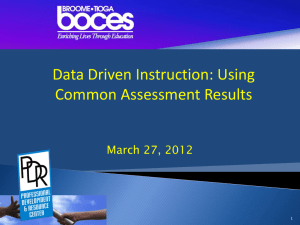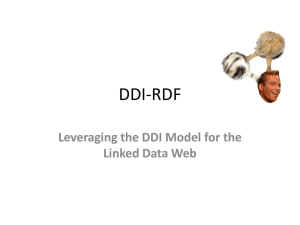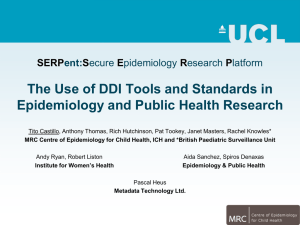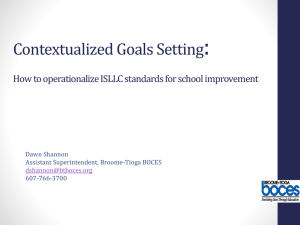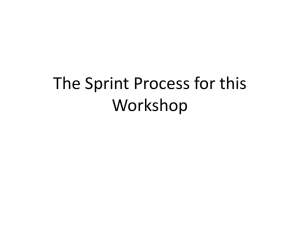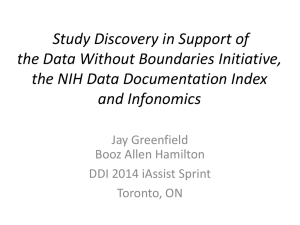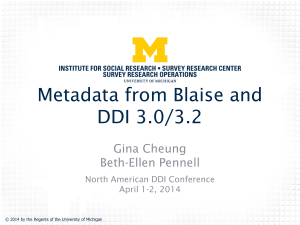What*s new with DDI 3.2 and beyond
advertisement
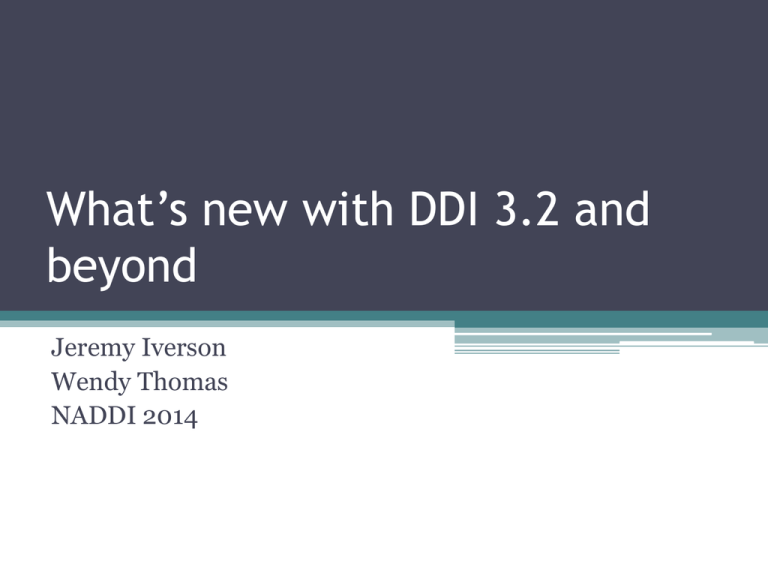
What’s new with DDI 3.2 and
beyond
Jeremy Iverson
Wendy Thomas
NADDI 2014
Agenda
• Changes and New Content in 3.2
▫ Changes in content that effect decisions to stay
with an earlier DDI version or use 3.2
• Improvements for Developers
▫ Structural and other improvements that support
the work of developers
• Moving Forward
▫ The projects, sprints, activities to date, and where
to find the details
Changes and New Content in 3.2
Changes in the structure of
existing content
• Bundling language equivalents in a single
element
• Representations and missing values
• Managing identification content
• Name clashes
• New Code Value Types
Changes in the structure of
existing content
• Bundling language equivalents in a single element
▫ Make sure multiple language content is complete
▫ Note where cardinality has been constrained in 3.2
▫ Loss of Identified Structured String – when multiple
languages are involved
•
•
•
•
Representations and missing values
Managing identification content
Name clashes
New Code Value Types
Changes in the structure of
existing content
• Bundling language equivalents in a single element
• Representations and missing values
▫ Valid and Invalid (Missing) Values are handled separately
in 3.2 – and probably into the future
▫ Create CodeSchemes that combine a CodeScheme of valid
values and a CodeScheme of invalid (missing) values
▫ Managed Representations (Numeric, Text, DateTime,…)
• Managing identification content
• Name clashes
• New Code Value Types
Changes in the structure of
existing content
• Bundling language equivalents in a single
element
• Representations and missing values
• Managing identification content
▫ Use URN’s! This is the only place where all the
content of the full object identification can be
expressed for Identifiable and Versionable types
• Name clashes
• New Code Value Types
Changes in the structure of
existing content
• Bundling language equivalents in a single
element
• Representations and missing values
• Managing identification content
• Name clashes
▫ Note where object names are changing (these may
be namespace specific)
• New Code Value Types
Changes in the structure of
existing content
•
•
•
•
•
Bundling language equivalents in a single element
Representations and missing values
Managing identification content
Name clashes
New Code Value Types
▫ Many attributes were changed to elements to support
external controlled vocabularies (CodeValueType)
▫ Constrain current content of these fields to values you
plan to provide in an external controlled vocabulary
New Content
• Complex Questionnaires
▫ Question Grids and Question Blocks
▫ Data Processing
▫ New representations and response domains
• Concept Management
▫ Conceptual modeling
▫ Managed representations and missing (invalid) values
• Content Management
▫ Quality and authority statements
▫ Reorganizing Organizations and Individuals
▫ Archiving submitted content
• Consistency
▫ Multilanguage content
▫ Geographic content consistency
▫ Scheme structure consistency
Complex Questionnaires
• The primary reason for using 3.2
• Complex questionnaires are defined as those using:
▫ Complex Question Grids
▫ Question Blocks - where a set of questions are related
to a specific stimulus item (common in educational
testing)
▫ Need for a broader set of response domains
Scales, capturing a mark on an object, geographic codes,
ranking, distribution, etc.
▫ Complex routing and reuse of data for calculations
Incorporating pre-loaded content
Extensive use of response information to inform the
content of dynamic text
Data validation done during the collection process
Question Grids
• Simple grids where a single response type such
as a Value or “Yes/No” response is required for
each item in a list
• Complex grids where the list may be provided or
entered by the respondent and multiple
responses may be required for each item in a list
(“Yes/No” plus a Value plus a Percent, etc.)
Did you visit any one of the following performances or facilities over
the past 12 months?
(Circle the correct response for each)
Yes
Yes
Yes
Yes
Yes
No
No
No
No
No
Yes
Yes
Yes
Yes
Yes
No
No
No
No
No
a theatre performance
a cabaret performance
a concert of classical music
an opera or operetta
a concert of popular music, pop, jazz, musical or
pop opera
a 'dance' event, houseparty
a ballet performance
the cinema
an art gallery
a museum
14. Please write down the names of the places you stayed overnight and the duration of the stays in chronological order separately.
14. Please write down the names of the places you stayed overnight and
the duration of the stays in chronological order separately.
Places you stayed overnight in
chronological order
Type of accommodation for overnight stays
(Please specify the number of nights)
In the vehicle
(Cruise, Yacht, Train, TIR)
05
06
07
08
09
10
Pension
village
Motel
Rented House
04
Own House
03
Youth
And Camp
02
Camp/ Caravan
01
Total number of
nights
Hotel
Name of the
place
(City, town, etc.)
House of a
relative or friend
Other (Please specify)
(…………………..........)
11
......
...............
................
.........
.........
.........
.........
......
...........
.........
.........
.........
...........
.....................................
......
...............
................
.........
.........
.........
.........
......
...........
.........
.........
.........
...........
....................................
......
...............
................
.........
.........
.........
.........
......
...........
.........
.........
.........
...........
.....................................
......
...............
................
.........
.........
.........
.........
......
...........
.........
.........
.........
...........
.....................................
Question Blocks
• Contains “Stimulus Material” (image, sound,
text, etc.) to which a set of questions pertain.
• The set of specific questions generally make
sense only in context of the stimulus material.
• Commonly used in educational testing
• Difference between a Question Block and
sequence of questions is the need to tightly tie
the questions to a specific stimulus material in
order to assess the comparability of the question
content
New representations/response
domains
• Response domains needed to capture information in
specialized situations:
▫ Marks on an image or audio/visual
▫ Ranking behaviors
▫ Controlled distributions
• Ability to use Geographic Structure and Geographic
Location content directly as a specialized code
representation
• Scales as response domains and value
representations
▫ The actual layout of scales may effect the accuracy of
the response
Concept Management
• DDI is not fully there but 3.2 dramatically improves
support for concept management and expression
• Alignment with GSIM content regarding Concepts,
Conceptual Variables, and Represented Variables
• Managed representations allow numeric, textual,
datetime and other representations to be captured
once and reused
▫ BONUS: managed representations can be mapped for
comparison, i.e. a numeric representation of age to a
coded set of age cohorts
Concept
Universe
Conceptual
Variable
Representation
Represented
Variable
May constrain the
Universe and
Representation for a
specific applied
usage
Variable
Content Management: Quality
• Capture information on Quality Frameworks,
Quality Standards, and other means of assuring
the quality of the data, metadata, and process.
• Quality statements can be referenced from many
levels within DDI
• Additional content to reflect authorization, legal
status, budget, and evaluation procedures have
been added
Content Management: Actors/Agents
• Organization Scheme content has been cleaned up
and stripped down
• Organization and Individual information can be
better managed over time (specific contact
information is time stamped, etc.)
• Relationships between any two Organizations
and/or Individuals is tracked separately under
“Relation”. Roles are assigned as part of the Relation
• Locations in DDI where names are associated with
specific roles within the context of the Study can
now reference an Individual or Organization
Content Management: Archiving
• Supports inclusion of all major packaging types as
submitted (deposited) content (StudyUnit, Group,
ResourcePackage)
• Supports Local Added Content of all packaging types
• Links Local Added Content to Submitted
(Deposited) content by mapping
▫ Local Object Reference
▫ Depository Object Reference
▫ Relationship Action (CodeValueType) i.e. Overides,
Deletes, Extends, Restricts, etc.
▫ Description
Language Consistency
• Bundling equivalent content expressed in multiple
languages
<r:Label xml:lang=“en”>What is it?</r:Label>
<r:Label xml:lang=“de”>Was ist das?</r:Label>
<r:Label>
<r:String xml:lang=“en”>What is it?</r:String>
<r:String xml:lang=“de”>Was ist
das?</r:String>
</r:Label>
Geographic content consistency
• Added composite geographies (Metropolitan
Areas – composite of counties)
• Improved management of geographic change
over time
• Added ability to use geographic structures
(names and codes) and geographic locations
(names and codes) directly as representations or
response domains
• Added ability to reference specific locations for
the purpose of defining Spatial Coverage
Scheme structure consistency
• All schemes have the following structural features
▫
▫
▫
▫
XxxxSchemeName, Label, Description
Inclusion of a scheme by reference
Object type included in-line or by reference
Object Group included in-line or by reference
• All schemes have an XxxxGroup to support grouping
for administrative or conceptual purposes
▫ XxxxGroupName, Label, Description, and
TypeOfXxxxGroup
▫ Universe and Concept references
▫ Subject and Keyword
▫ Group and object included by reference
What if I’m just starting out?
• A number of new tools are already available for
3.2
▫ Colectica
▫ Rogatus Platform
• If DDI-C or DDI-L 3.1 does it for you and there
are tools to support your work, USE THEM
▫ But….pay attention to the consistency changes
made in 3.2 to make your work easy to migrate
forward. These changes were made in anticipation
of future version needs.
Improvements for Developers
What’s New in DDI 3.2
and Beyond
NADDI 2014 - Vancouver, Canada
Controversial Thesis
DDI 3.2 is Simple
DDI 3.2 is Powerful
Document a Single Variable with DDI 3.1
<ddi:DDIInstance id="ddii1" version="1.0.0" agency="int.example">
<r:Citation>
<r:Title xml:lang="en">MyDdiInstance</r:Title>
</r:Citation>
<g:ResourcePackage id="rp1">
<r:Citation>
<r:Title xml:lang="en">MyResourcePackage</r:Title>
</r:Citation>
<g:Purpose id="purpose1">
<r:Content xml:lang="en">Not specified</r:Content>
</g:Purpose>
<l:VariableScheme id="varscheme1">
<r:Label xml:lang="en">MyVariableScheme</r:Label>
<l:Variable id="var1">
<l:VariableName xml:lang="en">age</l:VariableName>
<r:Label xml:lang="en">Age of the respondent</r:Label>
<l:Representation>
<l:NumericRepresentation type="Integer" />
</l:Representation>
</l:Variable>
</l:VariableScheme>
</g:ResourcePackage>
</ddi:DDIInstance>
<ddi:DDIInstance id="ddii1" version="1.0.0" agency="int.example">
<r:Citation>
<r:Title xml:lang="en">MyDdiInstance</r:Title>
</r:Citation>
<g:ResourcePackage id="rp1">
<r:Citation>
<r:Title xml:lang="en">MyResourcePackage</r:Title>
</r:Citation>
<g:Purpose id="purpose1">
<r:Content xml:lang="en">Not specified</r:Content>
</g:Purpose>
<l:VariableScheme id="varscheme1">
<r:Label xml:lang="en">MyVariableScheme</r:Label>
<l:Variable id="var1">
<l:VariableName xml:lang="en">age</l:VariableName>
<r:Label xml:lang="en">Age of the respondent</r:Label>
<l:Representation>
<l:NumericRepresentation type="Integer" />
</l:Representation>
</l:Variable>
</l:VariableScheme>
</g:ResourcePackage>
</ddi:DDIInstance>
Document a Single Variable with DDI 3.2
<Fragment>
<Variable>
<URN>urn:ddi:int.example:var1:1</URN>
<Agency>int.example</Agency>
<ID>var1</ID>
<Version>1</Version>
<VariableName>
<String xml:lang="en">age</String>
</VariableName>
<Label>
<Content xml:lang="en">Age of the respondent</Content>
</Label>
<VariableRepresentation>
<NumericRepresentation>
<NumericTypeCode>Integer</NumericTypeCode>
</NumericRepresentation>
</VariableRepresentation>
</Variable>
</Fragment>
The DDI 3.1 Way
<ddi:DDIInstance id="ddii1" version="1.0.0" agency="example.org">
<r:Citation>
<r:Title xml:lang="en">MyDdiInstance</r:Title>
</r:Citation>
<g:ResourcePackage id="rp1">
<r:Citation>
<r:Title xml:lang="en">MyResourcePackage</r:Title>
</r:Citation>
<g:Purpose id="purpose1">
<r:Content xml:lang="en">Not specified</r:Content>
</g:Purpose>
<l:VariableScheme id="varscheme1">
<r:Label xml:lang="en">MyVariableScheme</r:Label>
<l:Variable id="var1">
<l:VariableName xml:lang="en">age</l:VariableName>
<r:Label xml:lang="en">Age of the respondent</r:Label>
<l:Representation>
<l:NumericRepresentation type="Integer" />
</l:Representation>
</l:Variable>
</l:VariableScheme>
</g:ResourcePackage>
</ddi:DDIInstance>
The DDI 3.2 Way
<Fragment>
<Variable>
<URN>urn:ddi:int.example:var1:1</URN>
<Agency>int.example</Agency>
<ID>var1</ID>
<Version>1</Version>
<VariableName>
<String xml:lang="en">age</String>
</VariableName>
<Label>
<Content xml:lang="en">Age of the respondent</Content>
</Label>
<VariableRepresentation>
<NumericRepresentation>
<NumericTypeCode>Integer</NumericTypeCode>
</NumericRepresentation>
</VariableRepresentation>
</Variable>
</Fragment>
DDI 3.2: Focus on the Content
Study
Survey
Group
StudyUnit
Quality
Foundational
Data
DataCollection
Instrument
ControlConstructs
Question
PhysicalInstance
DataRelationship
Variable
Overview
Schemas
•
•
•
•
Simplified packaging
Clearer identification
More consistency
Bug fixes
Content
•
•
•
•
Data Collection Instruments
Harmonization
Groups
Data
Simplified Packaging
Simplified Packaging
New DDI Fragment allows simple listing of
DDI items
Web services can be item-specific
Useful for import and export
Ambiguous Location of Information
Where are Variables defined?
<DDIInstance>
<DDIInstance>
<Group>
<StudyUnit>
<LogicalProduct>
<LogicalProduct>
<VariableScheme>
<VariableScheme>
<Variable />
<Variable
/>
<DDIInstance>
</VariableScheme>
</VariableScheme>
<Group>
</LogicalProduct><StudyUnit> </LogicalProduct>
</Group>
</StudyUnit>
</StudyUnit>
</DDIInstance>
</DDIInstance>
<StudyUnit>
<LogicalProduct>
<DDIInstance>
<DDIInstance>
<VariableScheme>
<Group>
<ResourcePackage>
<Variable />
<StudyUnit>
<LogicalProduct></VariableScheme>
<LogicalProduct>
<VariableScheme>
</LogicalProduct>
<VariableScheme>
<Variable
/>
</StudyUnit>
<Variable />
</VariableScheme>
</Group>
</VariableScheme>
</LogicalProduct>
</DDIInstance>
</LogicalProduct>
</ResourcePackage>
</StudyUnit>
</DDIInstance>
</Group>
</DDIInstance>
<DDIInstance>
<ResourcePackage>
<VariableScheme>
<Variable />
</VariableScheme>
</ResourcePackage>
</DDIInstance>
Consistent Location of Information
<FragmentInstance>
<Fragment>
<Variable />
</Fragment>
</FragmentInstance>
Explicit Top Level Element
Explicit Top Level Element
<FragmentInstance>
<TopLevelReference>
<!-- Points to the PhysicalInstance-->
</TopLevelReference>
<Fragment>
<PhysicalInstance />
</Fragment>
<Fragment>
<Variable />
</Fragment>
<Fragment>
<Variable />
</Fragment>
<Fragment>
<Category />
</Fragment>
<Fragment>
<Category />
</Fragment>
...
</FragmentInstance>
Clearer Identification
Clearer identification
DDI items are identified using three
pieces that create a key
Agency
Name
Item Identifier
Item Version
Item Identifier should be unique
Recommend
using UUID
No more containership rules
Consistency
Consistency
DDI items can be used by reference
everywhere they are used
Most previously required elements are now
optional
DDI schemes all look similar
Cleanup
Spelling mistakes
Repeated use of the same element names for different uses
Bug Fixes
Bug Fixes
Hundreds of bugs reported in 3.1 are
addressed
Can describe hierarchical datasets!
Surveys and Data Collection
New Question Types
Surveys with Data Flows
DDI Parameters and Bindings
Question Grid: Roster
QuestionText
For each of your children, please provide the following information.
TextDomain
Name
Roster
CodeDomain
Gender
1
M/F
2
M/F
3
M/F
4
M/F
5
M/F
NumericDomain
Age
Rank
RankingDomain
Question Grid: Predetermined
QuestionText
Please rank your favorite ways to travel.
RankingDomain
Rank
Plane
CodeDomain
Train
Automobile
Boat
Bike
Foot
Question Block
StimulusMaterial
1.
2.
3.
What city is this? QuestionItemReference
How many buildings can you count? QuestionItemReference
How many boats can you count? QuestionItemReference
Other: Specify
1.
2.
What is your name?
How did you get to NADDI?
3.
.
Plane
CodeDomain
Train
Automobile
TextDomain with
AttachmentLocation
Other (please specify): ____________________
Thanks for taking the survey, Jeremy.
Scales
How great is this year’s NADDI conference?
Anchors
Low
Great
1
2
3
ValueIncrements
4
Greatest
5 High
Surveys with Data Flows
1.
2.
What is your name?
Jeremy
How did you get to NADDI?
3.
.
Plane
Train
Automobile
Other (please specify): ____________________
Thanks for taking the survey, Jeremy.
DDI Parameters and Bindings
What is your name?
Output: FirstName
How did you get to
NADDI?
Input: Name
Thank you, {Name}.
Binding
Source: FirstName
Target: Name
Groups
DDI 3.1: VariableGroups
Group variables together
Topic
Section
…
Nested
Create
a hierarchy of items using subgroups
DDI 3.2: Lots of Groups
Groups can be created of most
versionable item types
Groups can have assigned concepts,
subjects
InstrumentGroups and Batteries
InstrumentGroup: “Wechsler Adult Intelligence Scale”
TypeOfGroup: Battery
WAIS
Information
WAIS
Comprehension
WAIS
Arithmetic
WAIS
Similarities
…
Harmonization with Groups
QuestionGroup: “Age Questions”
TypeOfGroup: similar
Concept: age
How old are you?
What is your age?
What age are you?
What’s your current age?
Harmonization
RepresentedVariable
Variable
Variable
marStat2000
marStat2005
Variable
marStat2010
marStat
RepresentedVariable
Variable
marStat2015
Extended Data
What about when information does not
fit the DDI content model?
Previous Options
Abuse
tags
Extend the schemas
Don’t use DDI
DDI 3.2 UserAttributes
<s:StudyUnit>
<r:Citation>
<r:Title xml:lang="en">My Study</r:Title>
</r:Citation>
...
<r:UserAttributePair>
<r:AttributeKey>Contact</r:AttributeKey>
<r:AttributeValue>Alice</r:AttributeValue>
</r:UserAttributePair>
<r:UserAttributePair>
<r:AttributeKey>Data Custodian</r:AttributeKey>
<r:AttributeValue>Bob</r:AttributeValue>
</r:UserAttributePair>
</s:StudyUnit>
3.2: A Little Understated
Schemas
•
•
•
•
Simplified packaging
Clearer identification
More consistency
Bug fixes
Content
•
•
•
•
Data Collection Instruments
Harmonization
Groups
Data
Focus on the Content,
not Packaging and Arbitrary Rules
Study
Survey
Group
StudyUnit
Quality
Foundational
Data
DataCollection
Instrument
ControlConstructs
Question
PhysicalInstance
DataRelationship
Variable
DDI 3.2 is Simpler
- Attendee, DDI 3.2 Training Workshop at
the University of Michigan
DDI 3.2 is More Powerful
Active DDI 3.2 Projects
Longitudinal Data Harmonization and Extraction
Cognition Measurement Item Batteries
Question Banks
Survey Instrument Designers and Code Generators
(at least 4 of these projects)
Data Curation and Archive Workflow Management
Classification Management
Eurostat Quality Reporting
What else?
Thank You
Jeremy Iverson
jeremy@colectica.com
Web
colectica.com
Blog
blogs.colectica.com
Twitter
@Colectica
YouTube
youtube.com/colectica
NADDI 2014 - Vancouver, Canada
Moving Forward
DDI Moving Forward Project
• The DDI project began around 20 years ago with the aim
of creating a structured metadata standard for the social
sciences.
We are seeking to again improve the value we provide to
our members by creating a 'model-based DDI'. This next
generation DDI will:
▫ be easier to use,
▫ be able to be quickly adapted to changing future needs
▫ provide an even smarter and more economical way for
organisations to manage their metadata, and
▫ make it easier for you to interact with data from other
disciplines and standards.
An Agile Project
• In order to accelerate the development of DDI4,
it has been decided to use an Agile approach
• Agile project management is a 'start and adjust'
model, rather than a fixed plan
• This allows for the adjustment of plans to ensure
that user needs are being met
Project Deliverables
• Project deliverables will include a UML model for DDI 4 but also
XML and RDF bindings.
• The DDI Alliance will release two types of products to meet the
needs of a diverse audience:
▫ Functional Views - These views are in essence profiles of the full
specification oriented around specific user needs – for example, simple
data description, simple codebook, and discovery are functional views.
Most users would interact only with the Functional View(s) that interest
them. The DDI Alliance would publish a set of official standard views.
▫ The Library of Objects, which encompasses the entire DDI 4.0 model.
Objects are organized into packages in the Library. Packages are
mutually exclusive and comprehensive. This second product is intended
for use by more sophisticated users
Sprints
• Sprints are a way to further accelerate progress.
• During a sprint, participants brought together for a set
period to progress specific outputs and out comes.
• Key features of sprint process:
▫ Priorities are adjusted on an on-going basis
▫ The group is “self-organizing”
▫ Frequent plenary sessions and flexible assignments of
participants
▫ Groups are organized and re-organized based on the
perceived rate of progress and priorities of the deliverables
Activities to date
• Three sprints:
▫ Dagstuhl (October 2013)
▫ EDDI (December 2013)
▫ NADDI (March 2014)
• Virtual task teams – Following the sprints, a
number of task teams were created to follow up
work.
Want to know more?
• Minutes and formal products from the Dagstuhl and
EDDI sprints are found at the DDI site
▫ http://www.ddialliance.org/ddi-moving-forwardprocess
• A new public wiki has been established to maintain
and organize all working and final documents
▫ http://www1.unece.org/stat/platform/display/DDI4/
DDI+Moving+Forward+Project+Home
• Current development platform for content capture
▫ http://lion.ddialliance.org/
Want to get involved?
• It is open to participation from any interested
country or organisation, with a strong interest in
DDI.
• Participation is on a voluntary, unfunded basis,
therefore the specific outcomes will
automatically focus on areas considered to be
priorities for the participating organisations.
Technical Committee – ddi-srg@icpsr.umich.edu
